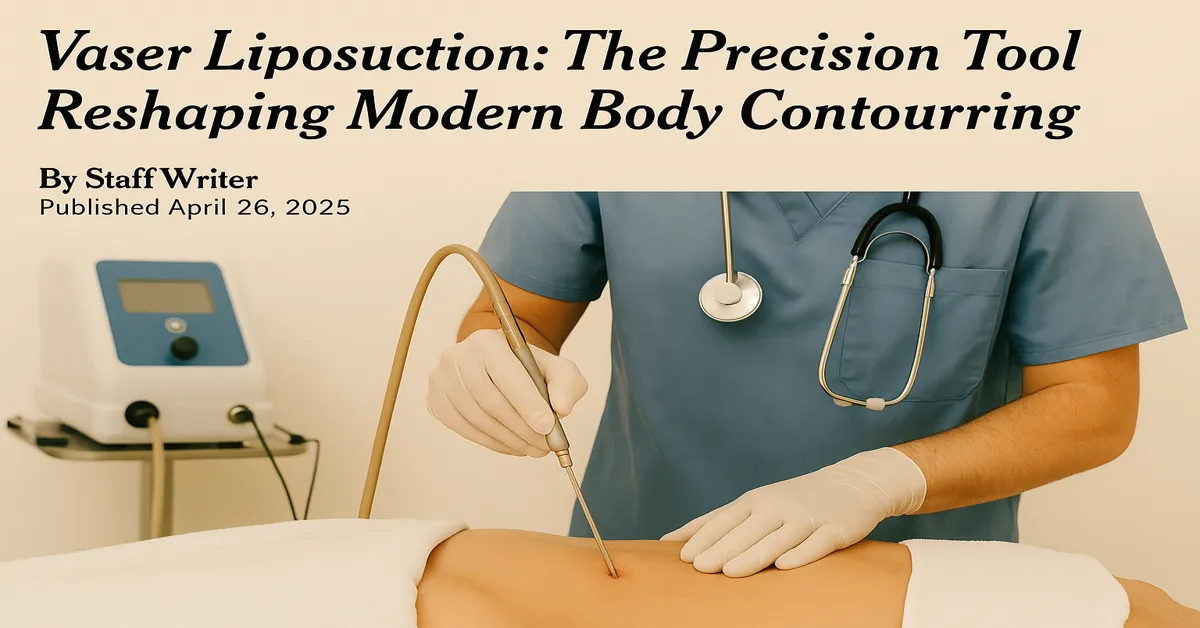In operating rooms outfitted with ultrasonic probes and medical-grade amplifiers, a quieter revolution is underway. Cosmetic surgeons, once armed with blunt cannulas and rigid suction tubes, are now relying on sound—ultrasonic energy, to be exact—to sculpt the human body – Vaser Liposuction.
It’s called Vaser Liposuction, and for a growing number of patients and physicians, it represents the future of fat removal.
Marketed as a gentler, more precise form of liposuction, Vaser (an acronym for Vibration Amplification of Sound Energy at Resonance) doesn’t just suck out fat—it emulsifies it with ultrasound, making the tissue easier to remove, and, its advocates argue, making recovery faster, results smoother, and risks lower.
But what does the science say? Who is getting it, and why now? And is Vaser really a breakthrough—or just another chapter in the never-ending story of cosmetic enhancement?
From Crude to Controlled: The Evolution of Fat Removal
For decades, liposuction has been one of the most popular cosmetic procedures in the world. The traditional technique, known as suction-assisted liposuction (SAL), involves manually breaking up fat cells and then extracting them through a hollow tube connected to suction.
It works. But it’s not elegant. Bruising, swelling, bleeding, and irregularities are common—especially when treating fibrous areas like the back or male chest.
Enter Vaser Liposuction, first FDA-approved in the United States in 2002, and now widely used in clinics across Europe, Asia, and South America.
Unlike traditional liposuction, which relies on mechanical force, Vaser uses ultrasound waves to selectively target fat cells without damaging surrounding tissue—like nerves, blood vessels, or connective fibers. This makes it particularly appealing in areas where precision is key.
How Vaser Liposuction Works: A Step-by-Step View
The procedure involves several distinct steps, typically performed under local anesthesia with sedation or general anesthesia depending on the treatment area and volume.
1. Tumescent Infiltration
A special saline solution mixed with lidocaine (a numbing agent) and epinephrine (a vasoconstrictor) is injected into the fat layer. This helps minimize bleeding and pain while expanding the tissue for easier targeting.
2. Ultrasonic Emulsification
A Vaser probe is inserted into the area. It emits high-frequency sound waves that liquefy fat cells, breaking them apart from surrounding tissue without causing thermal damage.
3. Fat Extraction
Once emulsified, the fat is suctioned out gently, typically through smaller cannulas, reducing tissue trauma and promoting a smoother contour.
4. Skin Retraction & Recovery
The thermal energy of the ultrasound may promote tighter skin retraction post-procedure. Patients usually wear compression garments for several weeks and can resume light activity within days.
Why Patients Are Choosing Vaser
Across clinics in New York, Dubai, Seoul, and São Paulo, surgeons report a steady increase in demand for Vaser procedures over the past five years. Patients are increasingly informed, demanding procedures that promise minimal downtime, natural-looking results, and fewer complications.
Among the most frequently cited reasons for choosing Vaser:
- Precision: Ideal for treating delicate or previously operated areas
- Muscle Definition: Can enhance athletic contours (e.g., six-packs)
- Lower Trauma: Less bruising and pain compared to traditional methods
- Fat Preservation: Extracted fat is viable for grafting to other areas (e.g., buttocks, breasts, face)
- Skin Tightening Effect: Mild thermal stimulation may aid elasticity
“I wanted a subtle refinement, not a drastic change,” says Alisha D., 37, a fashion executive in London who underwent Vaser liposuction on her flanks and thighs.
“What sold me was the promise of less downtime. I was back in heels within a week.”
Areas Commonly Treated With Vaser
The versatility of the technique has made it a popular choice for treating both large-volume and finesse areas:
- Abdomen and Waistline
- Love Handles (Flanks)
- Upper Back (“Bra Bulge”)
- Inner and Outer Thighs
- Knees and Calves
- Chin and Neck
- Male Chest (Gynecomastia)
- Arms (for ‘bat wings’)
In high-definition liposculpture, Vaser is used to carve muscle outlines, especially on the abdomen, giving the illusion of athletic tone—a procedure marketed as “six-pack surgery” in some clinics.
Vaser vs. Traditional Liposuction: A Technical Comparison
| Feature | Traditional Liposuction | Vaser Liposuction |
|---|---|---|
| Method | Manual suction of fat | Ultrasound emulsification |
| Pain & Bruising | Moderate to high | Reduced |
| Recovery Time | 2–4 weeks | 1–2 weeks |
| Muscle Definition | Limited | High-definition possible |
| Fat Graft Viability | Medium | High |
| Skin Tightening | Minimal | Moderate (due to thermal effect) |
| Ideal Candidate | Moderate fat reduction | Precision & sculpting seekers |
The Surge in Male Aesthetic Surgery and Vaser’s Role
While cosmetic surgery has historically skewed female, a new demographic is stepping forward—men in their 30s to 50s, particularly professionals and executives.
Vaser’s ability to create sharp, masculine contours without scars or extended downtime has made it especially appealing. In particular, male patients pursue:
- Abdominal etching
- Flank reduction
- Chest contouring (Gynecomastia correction)
In 2024, men accounted for over 22% of Vaser procedures globally, according to the International Society of Aesthetic Plastic Surgery (ISAPS)—a number that has tripled since 2015.
Cost Breakdown: Is Vaser Worth the Price?
Costs vary significantly depending on the region, clinic, physician experience, and number of treatment areas. In the U.S. and U.K., Vaser liposuction prices generally range:
- Small area (chin, arms): $3,000–$5,000
- Mid-size area (abdomen, flanks): $5,500–$8,500
- Large/Multiple areas: $10,000–$18,000+
While more expensive than traditional liposuction, patients often cite value in reduced recovery time, smoother results, and lower touch-up rates.
What the Science and Studies Say
The efficacy and safety of Vaser liposuction have been reviewed in peer-reviewed studies and clinical audits over the last two decades. Findings show:
- Reduced blood loss compared to SAL
- Better preservation of connective tissue
- Faster return to normal activity
- Higher patient satisfaction rates (85–95% depending on area and surgeon skill)
A 2023 study published in Aesthetic Surgery Journal followed 126 patients over 18 months and found significantly lower revision rates in Vaser-treated areas compared to traditional methods.
Risks and Considerations
No cosmetic procedure is risk-free. While Vaser liposuction is considered safe, complications can occur, especially in unskilled hands.
Possible Risks:
- Burn or thermal injury (rare with proper technique)
- Infection
- Asymmetry
- Fluid accumulation (seroma)
- Skin irregularities
- Numbness (usually temporary)
The key variable? The experience and certification of the surgeon. The technology is only as good as the hands using it.
Who Should—and Shouldn’t—Get Vaser Liposuction?
Ideal Candidates
- Adults within 15–20 pounds of goal weight
- Those with good skin elasticity
- Non-smokers
- Individuals with targeted fat deposits
Not Ideal
- Patients seeking weight loss solutions
- Those with significant skin laxity
- Individuals with bleeding disorders or chronic conditions
- Unrealistic expectations
The Recovery: What Patients Can Expect
Days 1–3
- Mild discomfort and swelling
- Drainage from incision sites
- Use of compression garments
Week 1
- Return to work (light duties)
- Stitches removed (if non-dissolvable)
Week 2–4
- Resume light exercise
- Swelling begins to resolve
Month 2–3
- Final results begin to show
- Most swelling resolves
Unlike traditional liposuction, Vaser patients often report feeling “normal” faster—a significant lifestyle benefit.
Vaser and the Ethics of Body Culture
Critics of the body contouring trend point out the growing normalization of cosmetic procedures, especially among younger patients. Social media filters, influencer culture, and before-and-after content fuel a perception that perfection is both attainable and expected.
There is also concern about surgical overuse in pursuit of unrealistic muscle tone—some clinics advertise “abdominal etching” with CGI-level precision, glossing over the complexity of healing, scarring, and maintenance.
Surgeons caution that Vaser, while powerful, is not a substitute for exercise or lifestyle changes. It is a tool, not a miracle.
Future Frontiers: What’s Next for Vaser and Beyond
The technology continues to evolve. Some of the innovations under development include:
- Vaser-assisted RF and laser combos for dual fat removal and skin tightening
- Robot-assisted precision Vaser tools
- AI-assisted imaging for real-time sculpting
- Cryo-protected fat grafting using Vaser-extracted cells
And as demand rises in non-Western markets, particularly India, the Gulf, and Southeast Asia, Vaser clinics are expanding globally with portable units and mobile surgical pods.
Final Thoughts: Is Vaser Liposuction the Future of Body Sculpting?
Vaser liposuction has emerged as more than just a medical procedure—it is a symbol of aesthetic precision, a refinement of previous techniques, and for many, a practical way to align one’s appearance with their inner sense of self.
It has also sparked wider conversations about body standards, technology’s role in beauty, and the fine line between enhancement and expectation.
But for those who approach it with realistic goals, a qualified surgeon, and self-informed motivations, Vaser liposuction may represent a new chapter in safe, targeted, and efficient cosmetic evolution.





